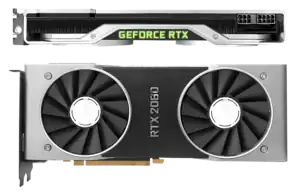
Nvidia RTX (also known as Nvidia GeForce RTX under the GeForce brand) is a professional visual computing platform created by Nvidia, primarily used in workstations for designing complex large-scale models in architecture and product design, scientific visualization, energy exploration, and film and video production, as well as being used in mainstream PCs for gaming.
Nvidia RTX enables real-time ray tracing. Historically, ray tracing had been reserved to non-real time applications (like CGI in visual effects for movies and in photorealistic renderings), with video games having to rely on direct lighting and precalculated indirect contribution for their rendering. RTX facilitates a new development in computer graphics of generating interactive images that react to lighting, shadows and reflections.[1] RTX runs on Nvidia Volta-, Turing-, Ampere- and Ada Lovelace-based GPUs, specifically utilizing the Tensor cores (and new RT cores on Turing and successors) on the architectures for ray-tracing acceleration.[2][3][4]
In March 2019, Nvidia announced that selected GTX 10 series (Pascal) and GTX 16 series (Turing) cards would receive support for subsets of RTX technology in upcoming drivers, although functions and performance will be affected by their lack of dedicated hardware cores for ray tracing.[5]
In October 2020, Nvidia announced Nvidia RTX A6000 as the first Ampere-architecture-based graphics card for use in professional workstations in the Nvidia RTX product line, replacing the former Quadro product line of professional graphics cards.[6]
Nvidia worked with Microsoft to integrate RTX support with Microsoft's DirectX Raytracing API (DXR). RTX is currently available through Nvidia OptiX and for DirectX. For the Turing and Ampere architectures, it is also available for Vulkan.[7]
Components
In addition to ray tracing, RTX includes artificial intelligence integration, common asset formats, rasterization (CUDA) support, and simulation APIs. The components of RTX are:[8]
- AI-accelerated features (NGX)
- Asset formats (USD and MDL)
- Rasterization including advanced shaders
- Raytracing via OptiX, Microsoft DXR and Vulkan
- Simulation tools:
- CUDA 10
- Flex
- PhysX
Ray tracing
In computer graphics, ray tracing generates an image by tracing rays cast through pixels of an image plane and simulating the effects of its encounters with virtual objects. This enables advanced effects that better reflect real-world optical properties, such as softer and more realistic shadows and reflections, as compared to traditional rasterization techniques which prioritize performance over accuracy.[9]
Nvidia RTX achieves this through a combination of hardware and software acceleration. On a hardware level, RTX cards feature fixed-function "RT cores" that are designed to accelerate mathematical operations needed to simulate rays, such as bounding volume hierarchy traversal. The software implementation is open to individual application developers. As ray-tracing is still computationally intensive, many developers choose to take a hybrid rendering approach where certain graphical effects, such as shadows and reflections, are performed using ray-tracing, while the remaining scene is rendered using the more performant rasterization.[10]
OptiX
Nvidia OptiX is part of Nvidia DesignWorks. OptiX is a high-level, or "to-the-algorithm" API, meaning that it is designed to encapsulate the entire algorithm of which ray tracing is a part, not just the ray tracing itself. This is meant to allow the OptiX engine to execute the larger algorithm without application-side changes.
Aside from computer graphics rendering, OptiX also helps in optical and acoustical design, radiation and electromagnetic research, artificial intelligence queries and collision analysis.
List of Nvidia RTX cards
Nvidia has released many cards that support RTX including the 20, 30 and 40 series.[11]
- Nvidia GeForce RTX 20 series
- Nvidia GeForce RTX 2060
- Nvidia GeForce RTX 2060 Super
- Nvidia GeForce RTX 2070
- Nvidia GeForce RTX 2070 Super
- Nvidia GeForce RTX 2080
- Nvidia GeForce RTX 2080 Super
- Nvidia GeForce RTX 2080 Ti
- Nvidia Titan RTX
- Nvidia GeForce RTX 30 series
- Nvidia GeForce RTX 3050
- Nvidia GeForce RTX 3050 Ti
- Nvidia GeForce RTX 3060
- Nvidia GeForce RTX 3060 Ti
- Nvidia GeForce RTX 3070
- Nvidia GeForce RTX 3070 Ti
- Nvidia GeForce RTX 3080
- Nvidia GeForce RTX 3080 Ti
- Nvidia GeForce RTX 3090
- Nvidia GeForce RTX 3090 Ti
- Nvidia GeForce RTX 40 series
- Nvidia GeForce RTX 4060 (AD107)
- Nvidia GeForce RTX 4060 Ti (AD106)
- Nvidia GeForce RTX 4070 (AD104)
- Nvidia GeForce RTX 4070 Ti (AD104)
- Nvidia GeForce RTX 4080 (AD103)
- Nvidia GeForce RTX 4090 (AD102)
- Nvidia A series workstation cards
- Nvidia RTX A2000 6GB/12GB
- Nvidia RTX A4000 18GB
- Nvidia RTX A4500 18GB
- Nvidia RTX A5000 24GB
- Nvidia RTX A5500 24GB
- Nvidia RTX A6000 48GB
- Nvidia RTX 5000 Ada Lovelace 32GB
- Nvidia RTX 6000 Ada Lovelace 48GB
- Nvidia A series server cards
- Nvidia A10
- Nvidia A50
- Nvidia A100 PCIe 40GB
- Nvidia A100 PCIe 80GB
- Nvidia A100 SXM 40GB
References
- ↑ Alwani, Rishi (21 March 2018). "Microsoft and Nvidia Tech to Bring Photorealistic Games With Ray Tracing". Gadgets 360. Retrieved March 21, 2018.
- ↑ Atlavilla, Dave. "Nvidia And Microsoft Lay Foundation For Photorealistic Gaming With Real-Time Ray Tracing". Forbes. Retrieved March 19, 2018.
- ↑ "Nvidia announces RTX 2000 GPU series with '6 times more performance' and ray-tracing". The Verge. Retrieved 2018-08-20.
- ↑ "Nvidia reveals $800 GeForce RTX 2080 at Gamescom 2018". CNET.
- ↑ Sarkar, Samit (2019-03-18). "Nvidia bringing new movie-quality graphics tech to GTX cards". Polygon. Retrieved 2019-03-19.
- ↑ Smith, Ryan. "Quadro No More? NVIDIA Announces Ampere-based RTX A6000 & A40 Video Cards For Pro Visualization". www.anandtech.com. Retrieved 2021-03-10.
- ↑ "Turing Extensions for Vulkan and OpenGL". NVIDIA Developer. 11 September 2018.
- ↑ "NVIDIA RTX™ platform". Nvidia. 20 July 2018.
- ↑ Jefferies, Charles. "What Is Ray Tracing? (And What It Means for PC Gaming)". PCMag. Retrieved 23 February 2022.
- ↑ Oh, Nate (14 September 2018). "The NVIDIA Turing GPU Architecture Deep Dive: Prelude to GeForce RTX". AnandTech. Retrieved 23 February 2022.
- ↑ "Nvidia Graphics Cards List In Order Of Performance". CG Director. 2018-09-26. Retrieved 2022-03-15.